Home
What's New
About Me
Rangefinders
Prismat
Fixed Lens
TL & DTL
XTL & X-1000
MSX & DSX
NC-1000
Z-Series
Other Mamiya
Instruction
Manual
Reprints
Related Links
Mamiya
35mm Camera
Auction Prices
Mamiya
SLR Lenses
Auction Prices
Rest of
Collection
FAQ
Mamiya
35mm
Forum!
How To!

If you would like to
make a donation to
help fund this site,
click below!
|
My Russian Cameras
Although most of my collection is devoted to Mamiya
35mm cameras, I do have a modest collection of other cameras, from
early Kodak folders to an old (but still functional) Burke & James
8x10 View Camera (that I am getting ready to restore). The cameras
on this page include my Russian-made 35mm rangefinders, SLR and medium-format
folders that were manufactured in the old Soviet Union. However, I
do not have any technical information about them, beyond what you
read here.
A Brief History
Production of the "FED" version of these Leica copies
was begun in 1934. The similar Zorki rangefinders were first produced
in Krasnogorsk, a suburb of Moscow, at a factory named for the location,
beginning in 1948. The factory, locally known as KMZ, the "Krasnogorsk
Mekanicheski Zavod" (Krasnogorsk Mechanical Factory) has produced
many Soviet cameras in addition to the Zorki, including the Zenit
35mm, the Zenit 80, the Horizont, the FT-2 and the Mir. The KMZ still
produces cameras today.
Write to me if
you have FED, Zorki or Mir information to share. |
|
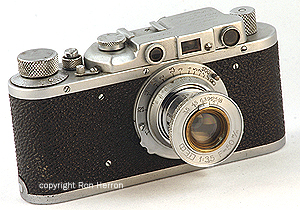 
FED type 1(C) (c.1939)
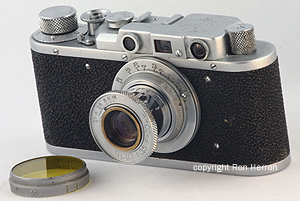
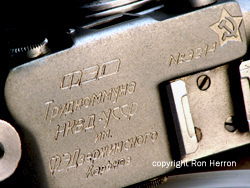
One of the earliest FED Rangefinders ?
(c.1934)
The Russian FED Rangefinder
The name "FED" comes from the initials of Felix Edmundovich
Dzerzhinsky, the founder of the Soviet secret police. The FED-1
(c.1934-55) was the earliest successful Leica II(D) copy, and the
only one achieving any measure of success before WWII. I have several
FED 35mm rangefinder cameras in my collection, although not all
of them are illustrated here.
FED NKVD CCCP & YCCP Rangefinder
The camera pictured above (top row; serial number
124420) has the FED NKVD CCCP logo engraved on the top plate,
which would indicate it is a FED type(1d) with a manufacture date
of 1939-41. However, the serial number is low enough to be a FED
type(1c) made from 1935-39 (the 1c usually had a "YCCP" engraved,
instead of the "CCCP"). These facts would seem to indicate this
camera was produced during that transition, which would be a date
of about 1939.
One of the Earliest FED Rangefinders?
The FED rangefinder pictured above, (bottom row - with the
yellow filter; serial number 3214), if authentic, would be one of
the earliest FED known. However, many FED rangefinders were repaired
at the factory, or otherwise altered, so that statement has to be
somewhat tempered. This camera has the Cyrillic "FED" logo and the
distinctive "hammer & sickle" that indicates it as one of the first
FED cameras made (c.1934), a very rare camera. Like typical FED
rangefinders, it has removable bottom plates for film loading, and
the lens is a collapsible 50mm Fed f/3.5 (apparently an early lens,
with no serial number) with shutter speeds of B, 1/20, 1/30, 1/40,
1/60, 1/100, 1/200 and 1/500. It has a focus lever near the body
mount to assist in focusing.
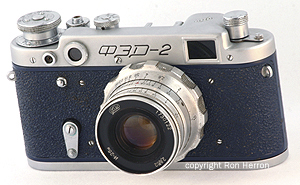
FED-2 Rangefinder, with blue covering
(c.1958)
"Blue" FED-2 Rangefinder
The FED-2 cameras were produced from 1955 into the
1970's. All models had a removable back, and a combined viewfinder/rangefinder.
From 1956-on they included a self-timer and flash sync. Early models
had a large, milled advance knob, and a collapsible lens similar
to those on the earliest FED models. Models, like the one pictured
above, made after 1958, had a new, smaller milled-edge advance knob,
and non-collapsible lenses with a large milled collar. Body coverings
were predominantly black, but examples do exist with coverings in
dark red, dark green, grey, sand and (like above) in very dark blue.
The various colors are found much less often than black.
|
|
Zorki-2C "Festival" Rangefinder
This camera is a rare Zorki-2C (serial number
57169574), produced in late 1957. It is rare in that it was produced
specifically for the Moscow International Festival of Youth (held
in 1957), and factory-engraved accordingly (see inset of engraving
on left side of top plate, bottom right).
The "2C" designation (see inset, below) is a misnomer
peculiar to English translations of the camera's Russian name. The
apparent "C" is actually the letter "S" in the Cyrillic alphabet.
The camera has a removable bottom for film loading; shutter speeds
from B, 1/30 to 1/500; the 5cm Industar-50 f/3.5 lens (serial number
5845953); a self-timer and a synch post on the front of the top
housing, the same features of the regular Zorki-2 (c.1955-60). It
also has a milled lens collar, instead of the usual focus knob.
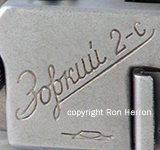
Zorki 2-C Top Plate
|
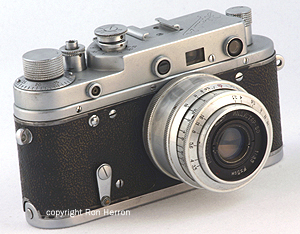
ZORKI 2-C (c.1957)
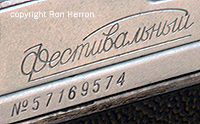
Engraving commemorating the
Moscow International Federation of Youth |
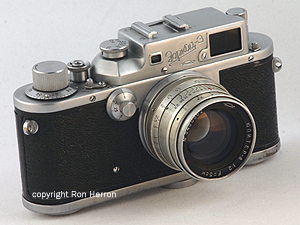
ZORKI-3 Rangefinder (c.1951-55) |
Zorki-3 Rangefinder
The Zorki-3 (left, c.1951-55) was a new design,
with more cast-metal parts, a longer body and a tallerer top housing
than the 2-C. It also had a larger 1:1 viewfinder combined with a
39mm base rangefinder. The slow speed dial was located on the front
of the camera body, and some came with a locking feature. |
|
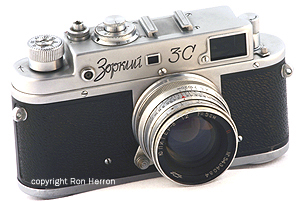
ZORKI 3-C (c.1955)
|
Zorki-3C
Rangefinder
The Zorki-3C (below left, c.1955-56) was similar
to the Zorki-3 and Zorki-3M (not pictured), but with a new longer
top housing. The sync contact was on the top front of the housing,
and it had no self-timer. Like the 3M, the slow speeds had been combined
with the fast speeds in a single top dial. Using a cloth focal plane
shutter, the Zorki-3C had a fully removable back for film loading,
and shutter speeds from 1/4 to 1/1000, including B.
This particular camera (serial number 5504427) was
produced in early 1955, and has a 5cm Jupiter-8 f/2.0 lens (serial
number 5434084).
|
|
Commemorative Zorki-4 Rangefinder
The Zorki-4 (c.1956-73) was virtually identical
to the Zorki-3C, but with a self-timer. It has a focal plane shutter
with speeds from 1 to 1/1000. It was the most common Zorki, with
more than 1.7 million manufactured. Variants could be found with
Roman lettering, as well as Cyrillic, and it could also be with
or without a viewfinder bezel (as this one is).
This particular model (serial number 67632645) was produced in 1967,
has a 5cm Industar-50 f/3.5 lens, and is in excellent condition.
Rarer than most Zorki-4's because of its edition, this Zorki was
stamped (see picture below, right) to commemorate the 50th anniversary
of the Russian Revolution in 1967. The commemorative Zorki-4 usually
brings about 33 percent more in the collectible market.

|
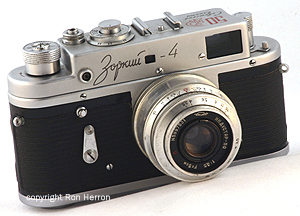
ZORKI-4 (c.1967)
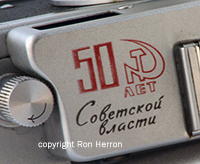
Stamped in commemoration of the
50th
Anniversary of the Russian Revolution |
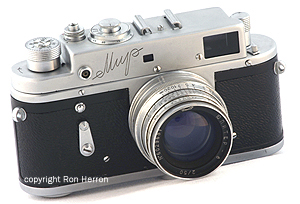
MIR ("Peace") Rangefinder (c.1960) |
Mir Rangefinder
Also produced in the Krasnogorsk factory, the Mir
(Russian for "Peace") rangefinder (c.1959-61) was essentially similar
to the Zorki-4, with removable back and self-timer, but it did not
have the slower shutter speeds.
This particular Mir (serial number 6054035) was
produced in 1960 and has a 50mm Jupiter-8 f/2.0 lens (serial number
6029681), and is in excellent condition, although it does have a
few very faint cleaning marks on the lens. Surprisingly, the Mir
is uncommon today, and can bring three- to five-times the price
of a Zorki-4 at auction.
|

START
SLR (c.1958) |
Start SLR
This Russian SLR (left, c.1958-64) was apparently inspired
by the early Exacta. The bayonet-mount lenses of the Start
(the Russian translation of its engraved Cryllic nameplate) have Exacta-style
shutter release arms. It has a cloth focal-pane shutter, and settings
include B and 1-1000. The normal lens was a 58mm Helios f/2. Once
considered very uncommon, they are appearing in the market with more
regularity, although finding one in operating condition is often still
a challenge. |
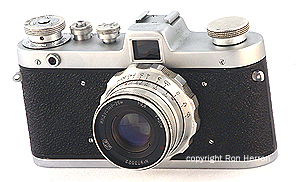
ZARYA
("Dawn") Rangefinder (c.1959) |
Zarya Rangefinder
The Zarya (bottom left, Russian for "Dawn" -
c.1959) was similar in many ways to the FED-2, but it had a restyled
and simplified top housing, using just a viewfinder, without the rangefinder.
This camera is also rare in auction, and fetches a surprisingly good
bid on the occasions it does appear.
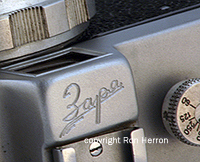
ZARYA Engraved
Cryllic Name |
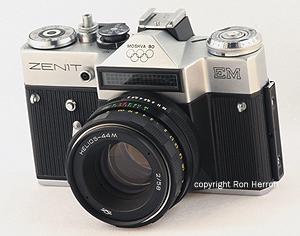
ZENIT EM (c.1980) |
Zenit EM
Zenit is a name associated with Russian SLR
cameras at least as far back as 1952. The model line is still being
produced today. This model is the Zenit EM (c.1965-81). It
has an uncoupled selenium meter and an automatic diaphragm, using
a 44mm Helios lens. In 1980, it was made in many combinations of chrome
or black body, with two different Olympic logos commemorating the
Russian hosting of the games that year.
This one has "Moshva 80" and the five interlocking
Olympic rings on the front of the top housing (see detail immediately
below). Another version had the Olympic rings at the base of a tower
(like the Zenit TTL shown next). During its years of manufacture it
was also sold as the Revueflex-EM and Cosmorex-SE.
 |
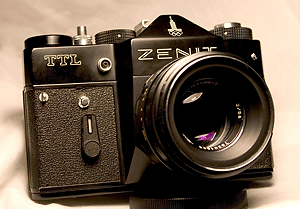
ZENIT TTL (c.1980) |
Zenit TTL
This particular camera model is the Zenit TTL
(c.1977-85). Similar to the Zenit EM shown above, it has stopped-down
match-needle metering, and an automatic diaphragm. Its standard lens
is a 44mm Helios. It was made in many combinations of chrome or black
body, and could have either Cyrillic or Latin lettering (like this
one).
This particular one was produced in 1980, and has the
five interlocking Olympic rings and a stylized torch on the top housing.
During its years of manufacture it was also sold as the Cambron-TTL
by Cambridge Camera in the USA.
|
Kiev-4 Rangefinder
The Kiev-4 rangefinder (right, c.1957) continued
a model line begun in 1947. The first Kiev cameras were assembled
from Zeiss-Ikon parts, and the total first-year production has been
estimated from a few dozen to a few hundred. Modeled after the Contax
III, it has a focal plane shutter with speeds from 1/2 to 1/1250,
including B, a flash sync on the front of the body, milled rewind
and film advance knobs and a self-timer. It used a 50mm Jupiter-8
f/2 lens. Production of the Kiev-4 model ended in 1980. |
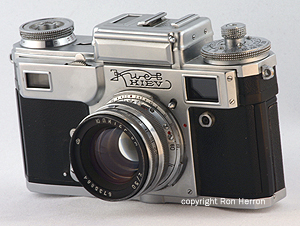
KIEV-4 Rangefinder |
KRISTAL SLR
Another addition to my Russian collection is this 35mm
Kristal camera (right, c.1961-62). It was produced by the Krasnogorsk
factory (if my references are correct, for only two years, with production
ending completely in 1962). Introduced at the same time as the Zenit-3,
the Kristal had several features borrowed from the Zorki-5 and Zorki-6,
all housed in a body heavily influenced by 1940s art deco. The body
was finished in either a black or grey hammertone enamel (like this
one), with art-deco ribs. |
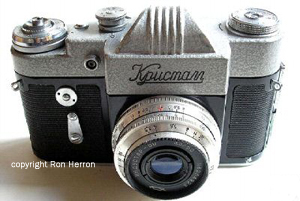
KRISTAL SLR |
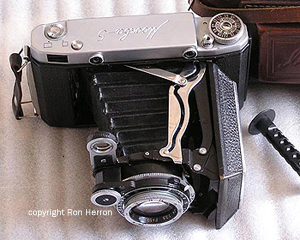
MOSKVA-5 (c.1956) |
Moskva-5
Another new addition to my Russian collection is this
medium-format (120 film) Moskva-5 (Moscow) rangefinder (left).
Produced by Krasnogorsk from 1956-60, it was essentially a copy of
the Zeiss Super Ikonta C. It also borrowed heavily from the Bessa
II. Unlike the Super Ikonta's pressed metal body, the Moskva-5 body
was die-cast. It has a streamlined top housing with integral optical
finder. An optional mask allows for 6x9 or 6x6cm images. It has a
10.5cm Industar-24 f/3.5 lens, in a Moment-24S 1-250 synchronized
shutter.

|
| |
Click here for my German
camera page, or my Kodak
camera page
© 2000-2010 R.L. Herron
All Rights Reserved. Legal
|
